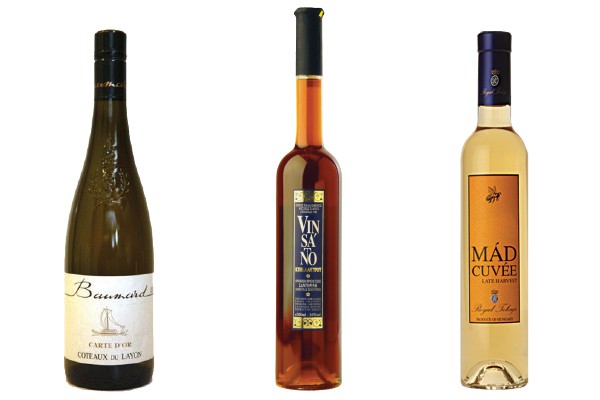
Sweet wines are the cheese lover’s secret weapon. It doesn’t matter what tomme your mother-in-law shows up with or what random assortment you’ve pulled from the cheese bin. When dealing with tangy goat cheeses, the lanolin funk of sheep’s milk, delicate young cheeses, or pungent washed rind wheels, sweet wines are truce-makers every time.
That’s not just because sugar is palatecoating and elementally pleasing; sweet wines (also called “stickies,” especially in Australia) tend to have no noticeable tannins, those drying, astringent elements prominent in the skin and seeds of grapes, and in the new wood barrels sometimes used to age wines. Tannins tend to wreak havoc when in contact with salt—something many cheeses are high in—which is why it’s often tricky to find cheese to stand up to a big, tannic red.
Sweet wines also have plenty of acidity, though you might not notice it under all that sweet fruit. Acidity, in fact, is what keeps the wine from feeling thick and cloying; it’s also what helps the wine stand up to the acidity in cheese.
Still, few people buy sweet wines anymore—which is another reason why you should. Sweet wines tend to elicit “oohs” and “ahhs” from guests, since many people never think to order a glass for themselves. And while they tend to be pricey, a little goes a long way. Sweet wines age extremely well, so a bottle or two will keep on hand for ages (in a dark, cool place, as any other bottle).

When it comes to choosing a sticky for the cheese course, whites tend to be more flexible than reds, and the best are made from grapes that have naturally high acidity, like riesling and furmint, chenin blanc or sauvignon blanc. They also usually come from cooler places, where the grapes can hang long into the fall, slowly accumulating flavor and complexity (often under netting to keep birds away).
Beyond these general factors are myriad possibilities. Some sweet wines are made simply from late-harvested grapes; others are made passito-style, in which grapes are left to dry slightly before pressing, which concentrates sugars. Some allow the botrytis cinerea mold that attacks grapes to do the concentrating; it adds a smoky, honeyed flavor. Others leave grapes hanging on the vine until the first hard freeze, then press the frozen berries to eke out sugar-rich syrup while leaving water behind as ice.

Royal Tokaji
2010 Tokaji Mad Cuvée Late Harvest ($21)
Tokaji used to be one of the most expensive wines in the world, the “drink of kings,” as it was called. Royal Tokaji was the first outside investor in the region after The Wall fell in 1989, and has worked hard to restore the vineyards to their former glory. While the region’s most hallowed wines are those made from botrytised grapes, this late-harvest cuvée gives a clear feel for the regional style, and at a very reasonable price: It’s as intense as dark orange marmalade yet light on its feet, thanks to the local furmint’s fiery acidity. It’s fabulous with blues as well as washed-rind cheeses.
Argyros
2007 Santorini Vinsanto ($30)
Although Tuscany gets most the attention for its golden vinsantos, Santorini has been famous for their versions since at least the 16th century. Made in a passito style, like the Tuscan versions, the grapes are dried slightly to concentrate their flavors before pressing. Based on the local high-acid assyrtiko, and aged for years in barrel, this is caramel in hue and flavor, a lush sweet wine with a sea salt minerality. Especially good with sheeps milk cheeses, or anything salty.
Domaine des Baumard
2011 Coteaux du Layon Carte d’Or ($26)
Chenin blanc makes some of the greatest sweet wines in the world, thanks to its indestructible high acidity coupled with its waxy, broad texture and sweet, floral quince-like flavors. Baumard is a Loire master; this cuvée is one of his less sweet and more versatile, with honeysuckle scents and tarte tatin flavors that seem to go with everything, especially Loire goat cheeses.
Pacific Rim
2012 Vin de Glacière ($16)
Ice wines—or Eiswein in Germany, where they are especially good—tend to be very expensive, since it is so hard to keep berries healthy all the way into the winter, and the yield from a frozen berry is so very small. Some wineries get around these difficulties by essentially putting the berries in a freezer, like Pacific Rim in Washington State. Made from organically-grown riesling, the Vin de Glacière (“wine of the icebox”) tastes of honey and pears, with a light spice, terrific with cheese.
Barton & Guestier
2010 Sauternes ($25)
Made from botrytised grapes grown on the cool Atlantic coast of France, Sauternes are some of the most exalted wines in the dessert wine world, and normally cost a pretty penny. This is a lucky exception, a honey-filled blend of semillon and sauvignon blanc from a négociant that made the best of a top vintage for Sauternes. Roquefort is the classic match on its home terrain, but it goes just as well with a stinky Éposses, too.




